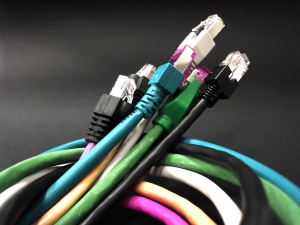 The mass media plays a large role in modern society. Indeed, many have argued that people spend more time watching television than in actual human interaction. The film industry is a billion dollar a year enterprise and most individuals tune in daily to their favorite radio station. With all this power, one would think that the mass media would be in an excellent position to initiate social change, positively affect social problems, and help combat social ills that are considered deviant. However, the mass media has largely failed in addressing social problems and if anything, has contributed to the problems that exist in this society. As seen through its presentation of the three major variables of race, class, and gender, the mass media has actually contributed to the social problems it covers, reinforcing them and the various stereotypes that exist, creating a vicious cycle in which these problems continue.
The mass media plays a large role in modern society. Indeed, many have argued that people spend more time watching television than in actual human interaction. The film industry is a billion dollar a year enterprise and most individuals tune in daily to their favorite radio station. With all this power, one would think that the mass media would be in an excellent position to initiate social change, positively affect social problems, and help combat social ills that are considered deviant. However, the mass media has largely failed in addressing social problems and if anything, has contributed to the problems that exist in this society. As seen through its presentation of the three major variables of race, class, and gender, the mass media has actually contributed to the social problems it covers, reinforcing them and the various stereotypes that exist, creating a vicious cycle in which these problems continue.
Television has become perhaps the primary vehicle that society receives its information and presents its values and expectations. One of the most important roles television plays is its presentation of news and information. What a station chooses to present as newsworthy can play a strong role in how people view their society and the world around them. Often, television news sources have a tendency to only broadcast negative images of minorities. On a nightly basis, individuals are bombarded with stories of minorities engaging in robberies, murders, and rapes, as if minorities are the only ones who monopolize these types of crimes. Very rare are the stories of the inner-city minority male youth who is a scholar or the young mother, who in spite of the odds stacked up against her, graduates from college. In this way, the television media plays a strong role in formulating racial problems. With the constant display of these negative images, two problems quickly emerge.
First, these minority groups become subject to stereotypes as the images presented become fixed mental images and are exaggerated and applied to the group as a whole. Whites, who are the dominant culture, watching the news, learn that minority groups are less intelligent, more violent, and generally less human. Additionally, the minority groups themselves can develop reactions that are turned inward and create a sense of hopelessness, despair, and self doubt that can lead into even more sociological problems in the form of alcoholism, drug abuse, aggression, and crime. Thus, the images presented by television news help contribute to this vicious cycle and offers little, if any solutions for the problem of racism.
Closely linked to race becomes issues of class. Since the lifestyles of poor, inner-city minorities are portrayed and viewed negatively; a flight of capital and economic activity develops in conjunction with the stereotypes. Those with capital avoid neighborhoods seen as violent or dangerous, and money is not spent or invested in these communities. Once this happens, minorities become trapped in an economic isolation that is devastating. Jobs quickly disappear, and welfare reforms are doomed to failure without hope of potential employment. Once the welfare system fails, the United States will further divide into two societies: one multiracial and reasonably prosperous; the other, disadvantaged and often dark skinned, living in semi-permanent poverty. As inner city minority neighborhoods become increasingly poor, there will be more sensational, negative stories of minorities while at the same time, ignoring other methods to present the problems of the inner city and offer feasible solutions.
 In regards to gender, although the television news media has been much more successful in promoting gender equality, as a whole, the mass media does not provide a balanced picture of the diversity of women’s lives and their contributions to society. The advertisement industry, which is a billion dollar a year enterprise, often emphasizes sexuality and the importance of physical attractiveness in an attempt to sell products, and this places undue pressure on women to focus on their appearance. These same advertisers use television as its main tool to send information to the public. Because of this obvious bias in advertisement, diseases such as bulimia and anorexia afflict millions of women and young girls, who are often made to feel insecure because of the constant stream of images of picture-perfect women who are often times digitally altered to suit the needs of the advertising industry.
In regards to gender, although the television news media has been much more successful in promoting gender equality, as a whole, the mass media does not provide a balanced picture of the diversity of women’s lives and their contributions to society. The advertisement industry, which is a billion dollar a year enterprise, often emphasizes sexuality and the importance of physical attractiveness in an attempt to sell products, and this places undue pressure on women to focus on their appearance. These same advertisers use television as its main tool to send information to the public. Because of this obvious bias in advertisement, diseases such as bulimia and anorexia afflict millions of women and young girls, who are often made to feel insecure because of the constant stream of images of picture-perfect women who are often times digitally altered to suit the needs of the advertising industry.
Mainstream television programming that reinforces women’s traditional roles is equally limiting to women in society. On a regular basis, rap music videos featuring nearly naked minority women, whose only role is to serve men, are seen by millions of people, reinforcing the myth that minority women are nothing more than sexual creatures that are “down” with whatever. These images do not help the rampant amount of sexism that exists in this society and creates an even wider chasm in the relationship between men and women, particularly amongst minorities. Also, according to an Associated Press release published in the Chicago Sun-Times, the three major television networks had fewer stories covered by minorities in 2004. This disturbing trend has occurred for the last three presidential election years in which minority journalists have reported only ten percent of the nightly newscast featured on ABC, CBS and NBC.
According to Robert Lichter, director of the Center for Media and Public Affairs, networks turn to familiar faces when it comes to covering presidential campaigns and for minority correspondents, familiar is a euphemism, and in this case synonym, for white.
Print media is another important vehicle in which social problems are developed. As in television media, there can be a large discrepancy in the types of coverage paid to issues of race, class, and gender. Newspapers, when formulating their reports and coverage, have a tendency to focus heavily on the problems of gangs in inner city minority neighborhoods. As a result, the print media has created an environment of great concern about gangs and gang crime in the inner city. The gang problem becomes a constructed image with great power in public discourse. The fight against gangs can be used to initiate social control even in areas where gangs are not a significant issue. Ironically, conformist juveniles are those most often affected by such control strategies, which take the form of curfews, dress codes, and rules of participation. Thus, the symbolic power of the gang metaphor lies in its successful application in settings where the gangs are relatively unimportant or inconsequential.
Whether it is used to justify or forbid a particular style of dress, defend skateboarding, or enhance a politician’s prospects on election day, the gang metaphor is a powerful tool for conjuring up an image that can be exploited by a host of social actors in the quest for power and the negotiation of social influence. Thus, print media can actually construct a social problem and portray it as more prevalent than reality would actually suggest.
 Print media also has great influence in class issues. By selecting ways in which to present a story on a labor strike, the print media can help influence the success of one class over another, and how these classes are perceived. Additionally, as described previously in relation to television news media, and linked to the issue of race is that media can further the economic difficulty of urban areas based on their coverage. Finally, print media can also reinforce and influence negative gender patterns and constructions through their coverage.
Print media also has great influence in class issues. By selecting ways in which to present a story on a labor strike, the print media can help influence the success of one class over another, and how these classes are perceived. Additionally, as described previously in relation to television news media, and linked to the issue of race is that media can further the economic difficulty of urban areas based on their coverage. Finally, print media can also reinforce and influence negative gender patterns and constructions through their coverage.
The mass media is important in examining social problems, both how they are born and how they persist. The media, through the selection of its coverage and the issues it chooses to present, is extremely powerful force in this society. Race, gender, and class are closely related as stereotypes perpetuated by the mass media about any of these three factors often leads directly to social problems in the other factors as well. The three are also closely linked in helping to explain why media operates in the ways that it does. The media may present information in the manner it does in order to perpetuate the social institutions and behaviors that have been functional for its existence up to the present time.
Additionally, the media can also be seen as operating in the manner it does because the system helps to keep rich, white, males ,whom are the primary owners and distributors of mass media, in a position of power. Although social problems have existed since the beginning of time, the media must be made more open to different perspectives and viewpoints in order to help eliminate many of the stereotypes that exist currently. Modern society must strive to make all of its media outlets a powerful tool in which the powerful voices of the oppressed can emerge to challenge different viewpoints on society.
When this occurs, this society will move closer to curing ills among the social variables that the current mass media in large part contributes to. The mass media has acted to perpetuate the social problems it covers. The mass media must be considered to be a large part of the problem in areas of race, class, and gender. In order to combat this situation, the mass media must formulate a new plan that makes itself more open to different perspectives and that will also challenge traditional models of race and class and gender.
Social Problems and the Mass Media,



Pingback: Using NLP To Seduce Women | New NLP Technology